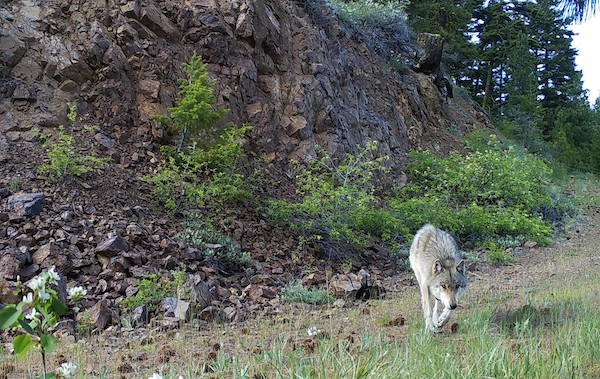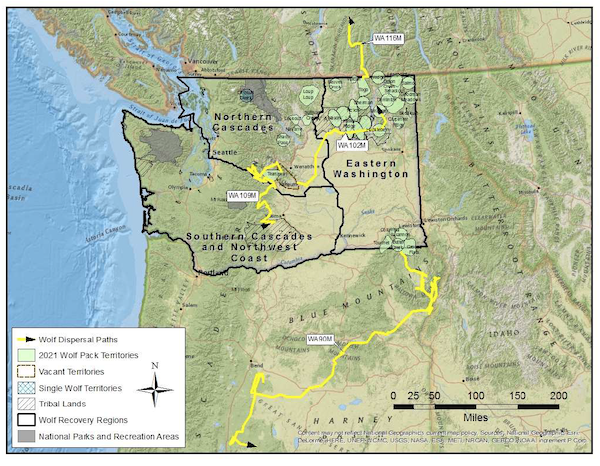
2 Wolves Traveling Together In Klickitat County
WDFW is reporting that a pair of wolves are traveling together in Klickitat County, a first for the area and Washington wolf recovery region.
In early April a state wolf biologist confirmed that the dispersing former Naneum Pack male was with another wolf, and then in late April a member of the public “observed two wolves together in the area the collared wolf had been frequenting at the time,” according to the agency.

The other wolf’s sex is unknown, Julia Smith, WDFW Wolf Policy Lead, said this morning. Previously the Naneum wolf hung out with another male.
The other Klickitat County wolf’s age is also unclear.
The details were first reported in WDFW’s April monthly wolf update. Smith declined to share more detailed information about the two wolves’ location, as the animals are “still moving around quite a bit.”
Until this year, Washington’s known wolves have pretty much only occurred in the state’s northeastern and southeastern corners and Okanogan Highlands – known as the Eastern Washington Recovery Region – and the eastern slopes of the North Cascades – the Northern Cascades Recovery Region.
The Naneum wolf, officially known as WA 109M, departed its territory between Ellensburg and Wenatchee last November and headed west before eventually crossing I-90 and continuing south through Kittitas County into Yakima County, both part of the Southern Cascades and Northwest Coast Recovery Region.

Its peregrinations led WDFW conflict specialists and wolf biologists to palaver last month with local livestock producers on ways to head off wolf-cattle conflicts, including “to emphasize the importance of livestock carcass sanitation and offered materials, labor, and services to help secure the carcass pile” with one rancher.
Just as it wasn’t clear what part of Klickitat County the wolves were in, the identity of the member of the public who saw them together was unknown – cowboy? turkey hunter? mushroom picker? mountain biker – but the news of duo will perk up the ears of big game hunters.
Even as Smith acknowledges this is “the first time WDFW has documented two wolves traveling together in this region,” she says they are not yet considered a pack or a breeding pair under the agency’s protocols.
A pack is defined as “two or more wolves traveling together in winter,” which is when WDFW performs its annual survey. Smith said that while wolf populations are dynamic – booming in late spring with the year’s pups and shrinking through summer, fall and early winter as animals die off – the benchmark is meant to be uniform year to year “so to have metrics that are comparable year after year so we can measure progress toward recovery.”
Wolves have been spotted and reported in Klickitat County in the past, but if I’m remembering correctly only one was ever confirmed by WDFW, a collared Oregon animal.
Smith said the two wolves could still be together at the end of the year, or they could split apart today.
“We’re keeping our fingers crossed that the South Cascades pair IS still together at the end of the year, and we could count them as the first documented South Cascades pack. But to make that designation now would be premature,” Smith said.
The state wolf management plan calls for full delisting – a pathway to a potential hunt, though increasingly less likely under this Fish and Wildlife Commission – to be considered when there are at least four successful breeding pairs in each recovery region plus three anywhere for three straight years, or four in each plus six anywhere in a single year. A successful breeding pair is two adults and two pups that survive through December 31.
The monthly wolf report also details a first calf depredation by the Vulcan Pack of far northern Ferry County northwest of Curlew and west of Danville.
And it indicates state wolf biologists are interesting in trapping and collaring wolves in the Navarre and Shady Pass Pack areas of Okanogan and Chelan Counties, as well as the Sherman and Wedge Packs of Ferry and Stevens Counties.
